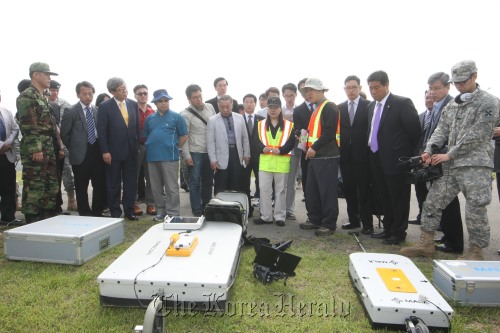U.S. says it has found no official records of orders given to remove materials yet
A U.S. Army commander told South Korean officials on Thursday that there was no confirmation that chemicals were removed from Camp Carroll, contrary to earlier statements that herbicides were disposed offsite.
Earlier in the month, Lt. Gen. John D. Johnson, commander of the Eighth U.S. Army and head of the Joint Investigation Team, cited a 1992 report that surveyed soldiers stationed at Camp Carroll.
The report said that drums containing pesticides, herbicides and solvents were buried in 1978 and subsequently removed and disposed “offsite” up until 1980.
But according to USFK officials, they have yet to find any official records of the orders given to remove the materials, but have “reason to believe” that something was buried there and subsequently removed.
Meanwhile, the Joint Investigation Team on Thursday began investigating Area 41 and Area D in Camp Carroll, looking for evidence of drums or ditches with ground-penetrating radar and sampling underground water.
 |
The Joint Investigation Team looks for buried toxic material using ground penetrating radar to look as far as 10 meters underground at Camp Carroll in Waegwan, North Gyeongsang Province on Thursday. (Joint Press Corps) |
South Korean officials had initially requested that underground soil samples be analyzed as well, but the USFK refused the request, adding that soil samples would be taken if an area was suspected to contain hazardous materials.
Water samples will be extracted by a company outsourced by the USFK and samples will be divided among Korean and U.S. officials for individual analysis. Both countries will reconvene with the results.
The two areas where the investigation started were named by Steve House and two other former U.S. soldiers stationed at Camp Carroll in 1978 in an interview with local U.S. news. Their claims that they had buried Agent Orange there caused a string of allegations from other whistleblowers to follow.
Korean officials are also looking to review the reports from 1992 and 2004 that the U.S. used as a reference during earlier briefings this month. The two U.S. military reports said that various chemicals were buried in 1978 but removed two years after, and that only trace levels of dioxins were found in the vicinity.
In light of the investigation, a local environmental organization said officials needed to prepare safety precautions should there be an accident during the investigation of the “most poisonous substance man has created.”
Some local officials and residents believe that Agent Orange is just the tip of the iceberg, saying that the U.S. military buried various toxic waste for other 30 years up until 1987.
Exposure to the herbicide, especially a component called dioxin, has been known to cause birth defects, neural illnesses and leukemia among other illnesses. More than 33,000 South Koreans who participated in the Vietnam War suffered from the after effects of exposure to the chemical.
The U.S. military is thought to have sprayed herbicides south of the Demilitarized Zone from 1968-1969 to allow easier detection of North Korean infiltrators into the south.
Controversy has continued over when exactly the U.S. sprayed toxic herbicides in Korea, with some claiming it was sprayed as early as 1955.
By Robert Lee (
robert@heraldcorp.com)








